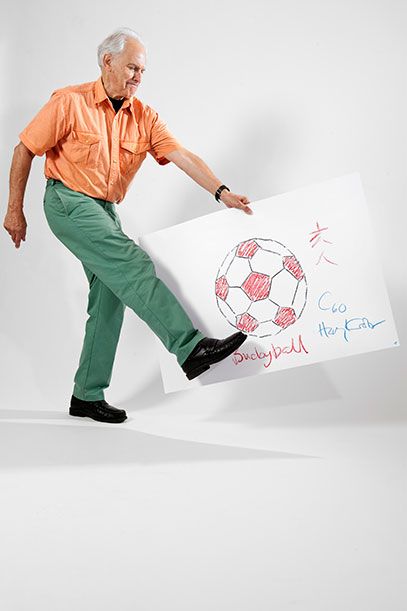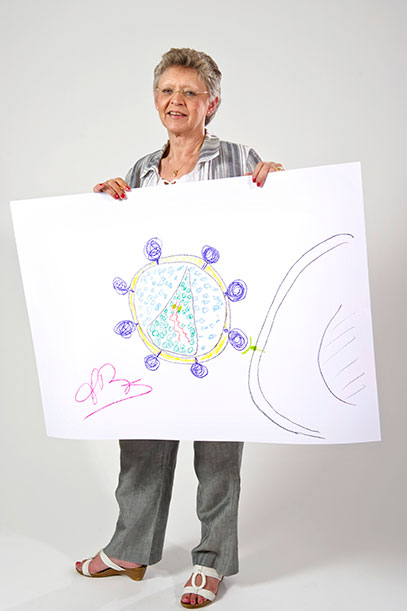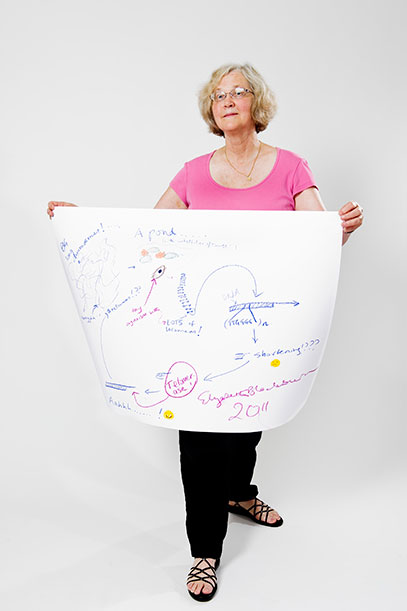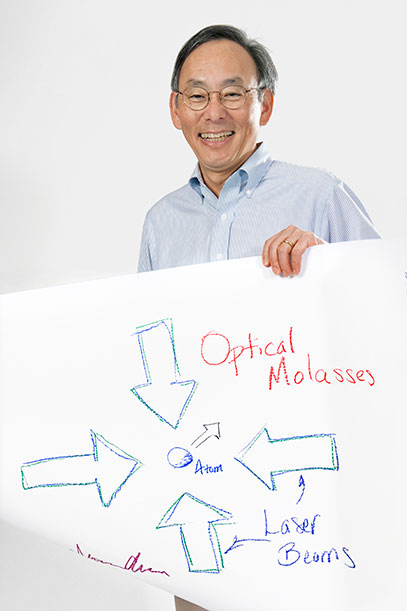Nobel Prize Winners Are Put to the Task of Drawing Their Discoveries
Volker Steger photographs Nobel laureates posing with sketches of their breakthrough findings
Robert Laughlin, 1998 Nobel Prize winner in physics. Laughlin and his colleagues were awarded for their discovery of a new form of quantum fluid with fractionally charged excitations. © Volker Steger
The idea came to Volker Steger while he was riding his bike from Munich to Milan. For an upcoming assignment with an Italian magazine, the German photographer was instructed to take portraits of a dozen Nobel Prize winners in science. His subjects would sit on his kitchen chair, and, to bubble up their personalities, he would ask them Proust-style questions. But, what if after the commercial shoot, while he still had the Nobel laureates in his presence, he ran his own artistic experiment?
Steger gave it a whirl. He handed the scientists large pieces of white paper and some crayons and asked them, on the spot, to draw their award-winning discoveries. Once they finished, he photographed them with their sketches in poses of their choosing.

Sir Harold Kroto, 1996 Nobel Prize winner in chemistry. Kroto and his colleagues earned the award for their discovery of fullerenes. © Volker Steger
CLICK HERE to listen to Sir Harold Kroto explain his discovery. Courtesy of Adam Smith, Nobel Media.
“The idea was, basically, to portray them in a way that was fun, personal and creative,” says Steger. “I wanted to visually link them directly to their discoveries.”
Pleasantly surprised with the results, Steger increased his sample size. For several years, starting in 2006, he attended the Lindau Nobel Laureate Meeting, an annual event in Lindau, Germany, where Nobel winners in physics, chemistry and physiology or medicine meet with students and young researchers. He pulled Nobel winners aside and, in a temporary studio with a white backdrop, presented the task.
“Nobody gets a prior warning. That is essential. I don’t want to get another Powerpoint presentation,” says Steger. “They come in, surprised by the lights and the setup. Then, I simply ask them to ‘make a drawing of what you got the Nobel Prize for.’”

Françoise Barré-Sinoussi, 2008 Nobel Prize winner in physiology or medicine. Barré-Sinoussi and colleagues were cited for their discovery of human immunodeficiency virus. © Volker Steger
CLICK HERE to listen to Françoise Barré-Sinoussi. Courtesy of Adam Smith, Nobel Media.
Steger’s 50 portraits of Nobel winners and their illustrations are featured in a book, Sketches of Science, and a traveling exhibition of the same title organized by the Nobel Museum. The exhibition is on display at Mainau Castle in Germany through August 25, 2013, and will head to Singapore from there.
Some of the Nobel laureates scrawled scientific formulas on the poster-sized paper. Françoise Barré-Sinoussi, Nobel Prize winner for physiology or medicine in 2008, drew the human immunodeficiency virus, looking somewhat like a Ferris wheel, to depict her and her colleagues’ discovery of the pathogen responsible for AIDS. And, Elizabeth Blackburn, the 2009 winner in the same category, depicted her discovery of how chromosomes are protected by telomeres and the enzyme telomerase in a series of doodles, connected by arrows and brought to life with exclamation points, happy and sad faces and sound effects.

Elizabeth H. Blackburn, 2009 Nobel Prize winner in physiology or medicine, was cited for the discovery of how chromosomes are protected by telomeres and the enzyme telomerase. © Volker Steger
CLICK HERE to listen to Elizabeth H. Blackburn. Courtesy of Adam Smith, Nobel Media.
Sir Martin Evans, the 2007 winner in physiology and medicine, needed two pieces of paper to communicate his work with embryonic stem cells. On the second sheet, he drew a mouse—a critter to which he is forever indebted (Evans introduced specific gene modifications in lab mice using embryonic stem cells). Leon Lederman skipped over his neutrino beam method and discovery of the muon neutrino, which earned him the 1988 prize in physics, entirely, and instead drew three figures celebrating. Above one figure is a speech bubble that says, “We got it!” And standing nearby is a female figure with a similar bubble containing three red hearts. Apparently, Lederman’s groundbreaking work won him the favor of a lady, as well as a Nobel.
The atmosphere at the Lindau Nobel Laureate Meetings is relaxed and creative, making it perfectly conducive for the project. ”I had only a few Nobels that turned down my request—maybe three out of 70,” says the photographer. “One said he was too old to draw.”
In his many shoots, Steger learned that most Nobel winners don’t actually like to be photographed as great thinkers musing in armchairs. Many held their sketches in front of their chests or their faces, and others showed more spunk. Robert Laughlin, the 1998 winner in physics, bit down on the corner of his drawing and used his free hand to point to an equation. Sir Harold Kroto, the 1996 Nobel winner in chemistry, made as if he was kicking his buckyball, a carbon molecule with the chemical formula C60 that looks like a soccer ball.

Steven Chu, 1997 Nobel Prize winner in physics, was acknowledged for development of methods to cool and trap atoms with laser light. © Volker Steger
CLICK HERE to listen to Steven Chu. Courtesy of Adam Smith, Nobel Media.
“Nobel laureates differ in their character just as much as they do in their discoveries,” says Steger.
Sir Timothy Hunt, the 2001 Nobel Prize winner in physiology or medicine, in his introduction to Sketches of Science, writes, ”There’s a playfulness about these portraits that’s quite beguiling, and unlike most official portraits of these distinguished people, there are hints that they don’t all take themselves that seriously, knowing very well that great discoveries result from a considerable degree of luck, as well as prepared minds.”
For the exhibition, the Nobel Museum pairs audio recordings of the laureates explaining their discoveries with the portraits. Listen to these recordings, found under the portraits in this post.
But it’s the picture—in this case, the picture of a picture with its artist—that makes Steger’s work so compelling. As Hunt explains, “What the photographs mainly seem to radiate is the fun of doing science.”
/https://tf-cmsv2-smithsonianmag-media.s3.amazonaws.com/accounts/headshot/megan.png)

/https://tf-cmsv2-smithsonianmag-media.s3.amazonaws.com/accounts/headshot/megan.png)